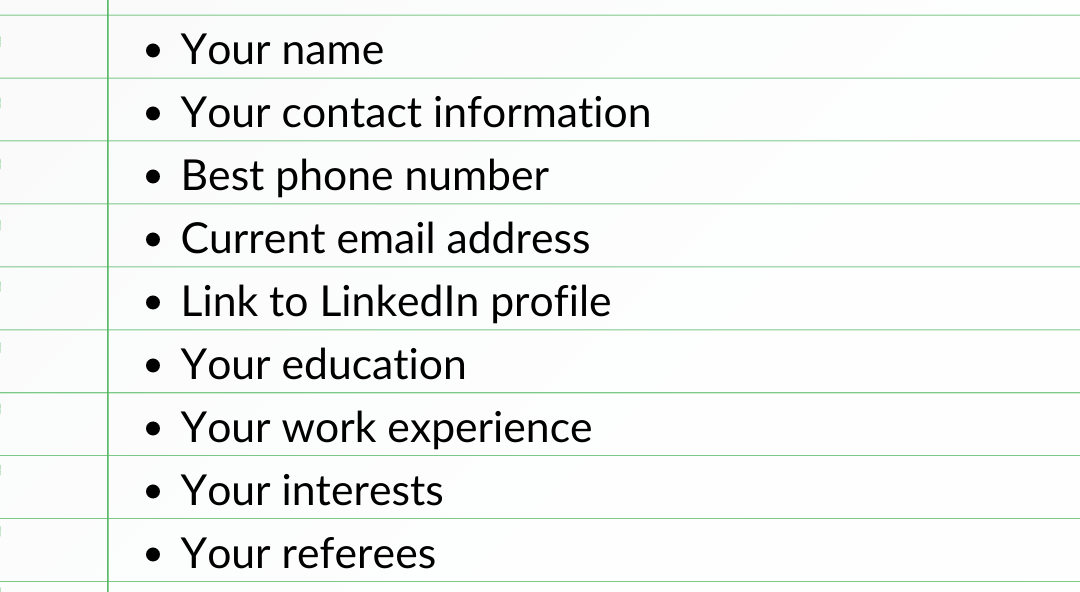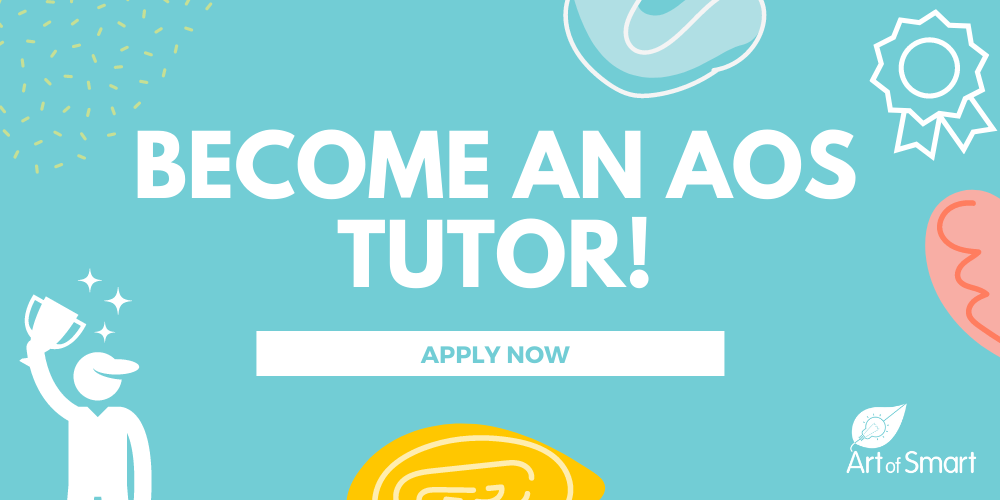
The HSC is over! Now what? After the HSC, you’re most likely thinking of getting a job — now that you’re done with being a high school student!
You might be thinking — I’ve just worked my arse off for 18 months for my HSC, I deserve a break, I can start thinking about a job after I’ve settled into university — and you can definitely do that!
But there are definitely some benefits towards finding a job right after finishing the HSC — so, let’s jump in!
5 Reasons to Start Job-Hunting Now!
Step 1: Get Your Resume Together
Step 2: Create a LinkedIn Profile
Step 3: List the Jobs You Want to Apply For
Step 4: Submit Your Application
Step 5: Follow Up with a Phone Call
5 Reasons to Start Job-Hunting Now!
Reason #1: Earning Money
This is obvious and the most practical reason — unless your parents are willing to fund the next 3 months of holidaying, partying and chilling out, you’re going to need to find a job after the HSC to earn some dollars so you can actually enjoy this freedom.
So, if you want to earn some money so you can actually enjoy the break, you’re going to need a job!
Reason #2: Your ATAR Doesn’t Matter after Year 12
The reality is that once you’ve got your ATAR, it doesn’t matter any more.
Ask anyone who’s already graduated and they’ll tell you that in the real world, your ATAR counts for very little. Sure, it’s important in terms of acting as a gateway to tertiary study and securing your place in a course at university.

What does matter however is work experience.
Employers don’t look at your ATAR, but at your experience.
Your ATAR is merely the threshold requirement. It gets you in the door for a interview, but it’s your work, life experience and communication & leadership skills that is the difference between getting hired or leaving empty handed.
And that’s why it’s key to start thinking about finding work so you can…
Reason #3: Build Your Skills
Given that in the real world your ATAR won’t matter after Year 12, and it’s all about the skills and experience you can bring to the table, getting a casual job now is a great way to start investing in developing your skills!
So when it comes time to finding a job in your dream career you will have a whole artillery of skills you can draw upon to excel and kick ass.
Reason #4: Build Your Resume & References
If you start now, you can get a head start on start building your resume and references so that when it comes time to make a move into your dream career, you’ve got all the skills, work experience, and references you need to make sure you get that job!
Some of the best advice I was given when I was finishing school, was “Work to learn, not to earn”.
The idea was that rather than find a casual job after the HSC that would simply pay the most, I was encouraged to find work that while I was young, would teach me the most so I could develop my skills for the future.
Learn how to build your first resume here!
Reason #5: You’ll Miss the Hiring Window
Sure you can wait until when you are at university, but most organisations start recruiting now — either for the Christmas period or for the next year. So if you wait until well after you’ve finished your HSC, you might miss the boat entirely trying to find a job!
Interested in working at Art of Smart? Find out more!
So, now that you’re convinced of why you should find a job after the HSC…
Here’s our 5 Step Guide to Getting a Job After Finishing the HSC!
Step 1: Get Your Resume Together

What should you include on your resume?
Each year we see more than 1,000 resumes — in fact, we’ve seen over 5,000 resumes over the last 6 years. From the good, bad to the down right ugly.
And based on this, we’ve identified some things you want to get right in your resume to make sure you make it to the interview stage of any job application.
First time writing a resume? Check out this resume guide!
Rule #1: Use Consistent Formatting
We see a lot of ugly resumes. Have you every landed on a web page that was ugly? It likely had way too much text, not much white space, and gaudy colours.
What did you do? I bet you closed it within 10 seconds.
And it’ll be the same with your resume, no matter how outstanding you might be.
HR and Recruiters see a lot of resumes, and they won’t have the time to dig through your resume to find the hidden gold. It need’s to smack them in the face as soon as they open your resume.
This way they can immediately without needing to invest valuable time, move your resume to the ‘To Interview’ pile, as opposed to the ‘Not Interested’ pile.
So, what does this mean for your resume?
Fonts – Type, Size, Colour
- Use 2 different fonts at a maximum – don’t use any more than 2. One font for headers, one font for text. Or use the same font for both!
- Your font size should be at a minimum 11 although 12 is better for readability. Any smaller and the HR manager will be squinting!
- Don’t use lots of colours on your resume – keep it simple. Black text is good. Make sure there’s lot of white space to improve readability.
- Use a font from this list here
Document Format
- Always send your resume in as a PDF – never send it in as a Word Document. Why? Word Documents load differently on each device and your carefully formatted document can go haywire. PDF’s lock in your formatting so you can be certain it’ll look great on any device!
Formatting
- Proof read like crazy – spelling mistakes, and grammatical errors are inexcusable! A HR manager can use this to ascertain that you don’t have good attention to detail and are lazy.
- Have a clear information hierarchy – use headings, sub-headings and dot points to make it easy for a busy HR manager to scan your resume and take in the key points.
Rule #2: Use a Clear Structure
Using a clear structure for what you include in your resume is also very important as this will improve the ‘scannability’ of your resume!
Here’s our recommended structure based on the thousands of resumes we’ve seen:

Keep your resume if you can to 2 pages, tops.
Use reverse chronological order, starting with what you’ve done more recently first. This way recruiters don’t have to go digging through your whole history to see what’s most relevant.
Rule #3: Sell Yourself
Most resumes are horribly boring to read. That’s the truth. They should be an incredible sales pitch for you, but more often than not, they read like an obituary. They read like a list of boring accomplishments, someone did a long time ago.
So, when you put your resume together, don’t be humble, don’t be shy. It’s your opportunity to brag, boast and to sell yourself (with no filters!).
Here’s 3 simple tips you can use that will help you better sell yourself!
Sales Tip #1: Quantify Your Impact
Instead of saying:
- As part of my role as a school prefect I delivered presentations to students, teachers and the local community
Quantify your impact:
- As part of my role as a school prefect in the student leadership team, I was responsible for delivering 15 presentations through 2019 to audiences totalling 2,500 people including students, teachers, parents and the local community.
Why?
Firstly, you’ve provided evidence to show and underscore the significance of your accomplishments.
This is a lot more persuasive and better highlights your skills. In the first example, for all I know, you delivered 1 presentation to 5 people.
Secondly, by quantifying, it makes you stand out from everyone else who ‘delivered presentations’ when you’re searching for a job after the HSC. You’re now known as the person who has ‘extensive’ public speaking expertise.
Sales Tip #2: Cause and Effect
When highlighting your accomplishments, don’t simply state them, but rather tell a story to show (not just tell) the HR manager how good you are.
Instead of saying:
- Helped my school create a solar energy project to improve our carbon footprint
Say:
- Reduced my school’s carbon footprint by 10% by project managing the development of a solar installation on 2 buildings
So the structure is: Result You Achieved by Specific Action You Took.
Sales Tip #3: Show the Competition
So many people achieve impressive things, get into elite programs, win amazing scholarships, but don’t show the competition that was overcome to achieve these accomplishments.
As a result, while it may be impressive, the HR manager won’t know it’s impressive (unless they happen to be very familiar with the specific accomplishment). As a result, show the competition.
Instead of saying:
- Top 10 of my school for English
- ATAR of 95
Say:
- Placed in Top 10 out of 250 students for English
- ATAR of 95, placing me in Top 5% of 70,000 students in NSW
Rule #4: Highlight What’s Unusual or Unique About You
Interests and hobbies should be ‘interesting’ to read. But it never is.
Usually a hobbies list reads like:
- Reading
- Sport
- Exercise
- Skiing
- Yoga
- Movies
How original!
The point of including your interests and hobbies is that you want them to spark and emotional connection with your interview, to help you build rapport and give you a better chance of getting the job, now that you’ve been on the hunt after the HSC.
So, make them specific, unusual, and unique!
- Reading Fantasy Novels by George R Martin (I’ve actually read the Game of Thrones books!)
- Playing European Handball (Yes, it’s actually a sport!)
- Running Ultra-Marathons (OK, I’m a little crazy)
- Watching Martin Scorcese movies (Who doesn’t love ‘The Departed’!)
Rule #5: Make it Easy for You to Be Contacted
At the end of the day this is the goal of submitting your resume: to be contacted for an interview.
So you need to make it really easy for the HR manager to get in touch with you. This means make sure your contact information is front and centre at the top of your resume.
And make sure your contact number has spaces in it.
What do I mean?
Don’t include your number like this: 0412345678
Why? It’s hard to read without spaces and it’s easy when inputting it in a phone to make mistakes.
Always include your number with spaces like this: 0412 345 678
Action Point:
- Open a document and begin writing your Resume
- Make sure you use consistent formatting and a clear structure
- Sell yourself by quantifying your results, and including the competition
- Make it really easy to be contacted!
Looking for even more tips on crafting the perfect resume? Check out our guide here!
Step 2: Create a LinkedIn Profile

What is LinkedIn?
It’s a professional social network that enables you to highlight your work experience, education and skills, while connecting with other professionals, employers and recruiters.
Why join LinkedIn?
It’s a great place to start building your professional persona and network, connecting with people in your chosen industry, building a public record of your skills, references and experiences.
Additionally, it’s also a tool heavily used by recruiters and HR managers to find great people, and to reference check. Now that you’re done with the HSC, this is a great way to build up your professional network and search for jobs!
But don’t just take my word for it, I chatted to Alex Pirouz the CEO of Linkfluencer, Australia’s #1 LinkedIn training company about how important it is for high-school students and recent Year 12 graduates to have a LinkedIn profile!
How do you get started on LinkedIn?
And then get started creating your profile!
If you’ve developed your resume already, you’ll discover that LinkedIn profiles are a digital version of your resume so it should be easy to build your profile quickly.
Once you’ve created your account, I’d love to connect with you! Here’s my profile – see you on LinkedIn!
Action Point:
- Sign up for a free LinkedIn account here
- Create your LinkedIn profile
- Connect with me on LinkedIn
Step 3: Create a Hit List of Jobs You Want to Apply For After the HSC

There’s two different approaches you can take to find a job to apply for:
- Based on industry/job type
- Based on geographic location
Industry Type
Think about the types of work you think you might want to do — be it because of the skills you can learn, the career you might want to enter, or what you think you will enjoy.
For example:
- Retail
- Hospitality
- Construction
- Tourism
- Professional Services
- Sales
- Education
Action Point:
Now that you’ve picked your industry, brainstorm the companies that work in the industry and write a list. Find their ‘Careers’ page and look to see if they’ve got any openings!
Geographic Location
The second method for looking for a job is to attack it through the lens of your geographic location.
What companies and organisation are based in your local area?
Action Point:
Write a list of all of the potential companies in the local area that could be looking for team members.
Looking for rewarding work that’s local, flexible and fits around your university schedule?
At Art of Smart we’re currently hiring passionate academic tutors and mentors for 2022!
Find out more about becoming an Art of Smart Tutor & Mentor and our application process here!
Step 4: Submit Your Application

Writing Your Cover Letter
Some jobs require you to submit a cover letter.
What is a cover letter?
Your cover letter is your introduction of yourself to the employer and a short, succinct summary of why you are a great fit for the job that is being advertised.
How do you write your cover letter?
Here’s a great resource we’ve put together to help you write a killer cover letter!
Make sure your cover letter stands out!
Most cover letters are extremely generic. They read like a template that the person has quickly adapted using ‘Find and Replace’ for employer name and job title.
HR and recruiters use cover letters to quickly identify if you’ve met the minimum criteria they are looking for to fill the available job role.
So once again it comes down to that idea that you don’t want to have to make a recruiter ‘dig’ in your cover letter or resume to determine whether you should be put in the ‘To Interview’ pile.
You need to use the cover letter to make sure you stand out immediately.
So this means that despite the urge to use a template, you need to take the time to adapt your cover letter so that it specifically answers the job criteria. You have plenty of free time after the HSC, so really dedicate some time to writing up your cover letter for a job.
If you hit the job criteria clearly on your cover letter, you’re giving yourself the best shot of getting an interview!
Action Point:
- Write your cover letter – keep it to 1 page maximum – the shorter the better
- Identify the specific job criteria and show how you nail these criteria in your cover letter
Tips for Submitting Your Application
So you’ve now written a custom cover letter that addresses the specific job criteria. Now what?
Tip #1: Follow the Application Steps to the Letter
When it comes to submitting your application, make sure you follow the steps in the job application down to the letter.
Some HR departments and recruitment agencies will include ‘Easter Eggs’ to determine who are the best applicants to interview – especially if they get an overwhelming amount of applicants.
What’s an ‘Easter Egg’?
Basically, it’s a specific instruction somewhere in the application process that you need to include in your application. If you don’t, you won’t be considered for the role.
For example if could be:
Include the sentence in the last line of your cover letter “I love chocolate and am looking forward to hearing from you!”
Regardless if there is or isn’t a ‘Easter Egg’ in the application process — the more closely you follow the application process, the better chance you have of making it to an interview!
Tip #2: Proof Read Your Email
We have received hundreds upon hundreds of emails from potential job seekers that have had grammatical and spelling mistakes in their email.
This is the first impression you make to a prospective employer – and if you’ve got mistakes in your email, you’re making a bad first impression!
So make sure you proof read your email and any contact you have with a prospective employer!
Learn about how to write a professional email here!
Tip #3: Include Your Contact Information!
This might seem obvious, but we’ve also received lots of applications that don’t have contact numbers to call people.
Make it easy for the employer to call you!
Action Point:
- Follow the application process to the letter and watch out for Easter Eggs!
- Proof read your email twice – make sure you’ve got no spelling or grammatical mistakes
- Make sure you include your contact information so it’s easy for the employer to call you!
Step 5: Follow Up with a Phone Call

Companies and HR departments often get A LOT of job applications. It’s easy for a great application to get overlooked, or lost in the pile.
Making a follow up phone call is critical to place yourself front and centre for the HR person.
Out of sight, out of mind. So your goal is to stay top of mind.
Making a follow up call shows lots of initiative, persistence and hustle — 3 things that will advance your application. So make the follow up phone call!
Rule #1: Identify Your Goal
Before calling, take the time to write down what outcome you’d like to achieve from the phone call. This is important so you can go into the call with a clear goal.
Your goal from the follow up call should be to get an interview.
So make sure you’ve identified potential times you may be available for an interview.
Rule #2: Be prepared to leave a message
The person you’re needing to speak to may not be available to chat with you, which means you’ll need to leave a message which needs to sound professional.
Before you make the phone call, write down a couple of notes of what you will say in your voice message.
Good things to include in your voice message:
- Your name
- Why you are calling
- The specific job you’re inquiring about (the company may be filling a number)
- Your contact number – repeat this twice to make it easy to be written down
Rule #3: Ask for feedback
If you get to speak to someone and they let you know you haven’t been successful be prepared to ask for feedback.
Here’s a couple of questions you can use:
- What would I have needed to demonstrate to have been asked in for an interview?
- What 2 things could I have done differently to have been successful for this role?
Action Point:
- Always make a follow up call 3-5 days after you’ve submitted your application
- Identify your goal before your call
- Be prepared to leave a voice message
- Always ask for feedback
Looking for a job after the HSC to help you get into your dream career?
We’re looking for world-class tutors and mentors to join our team!
We offer tutoring and mentoring for Years K-12 in a large variety of subjects, with personalised lessons conducted one-on-one in students’ homes, online or at one of our state of the art campuses in Hornsby or the Hills!



